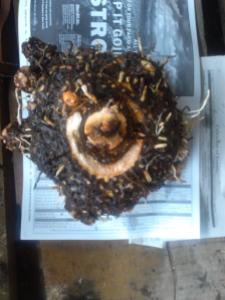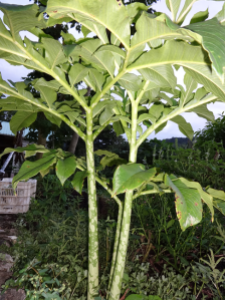
If you recall in a previous article, there is a certain ground root that we coined “The Brain” because well, we thought it looked like a big brain!

Kind of…you really have to be a doctor to appreciate the brain thing. Other names are Amorphophallus paeoniifolis or elephant foot yam.
This is what the plant looks like:

It has a characteristic spotting on the stem and it also produces a beautiful flower. Ours hasn’t flowered yet so sorry, no picture as yet.
The good thing about this yam is that it can be harvested and stored for about 3 months. This is great for the tropics because most ground vegetables have to be processed soon after harvest or else they go bad…take for example cassava. Anyway, I left this brain out on the veranda for months before I found the time to sort it out. This is how you prepare elephant foot yam:
Wear a pair of gloves whilst processing as the uncooked root contains oxalic crystals which can cause itchy dermatitis. Firstly pare the root with a sharp knife and then cut into uniform cubes about an inch in size. Wash thoroughly with water.

Next, place in a cooking pot with a teaspoon of salt. Bring to boil and cook for about 30 to 40 minutes. After this, add about 100g (3oz) of cream cheese to the pot and boil for another 10 minutes. Traditionally, in Indian cuisine, curds or tamarind paste are added at this point to further remove the itchy sensation caused by the oxalic acid. I had neither ingredient in my kitchen, so I opted to use Philadelphia Cream Cheese which seemed to work in the same way.

Once tender, drain off the water. You can eat it at this point or bag it into smaller portions to store in the freezer. The yam can be eaten as a substitute in any potato dish and there are numerous traditional recipes on the Internet; usually in the form of wet and dry curries.

This yam grows prolifically in the Tropics and so I recommend that every self-sufficient person should have a patch of this growing somewhere on their land. This is great survival food because there is so much of it!
0